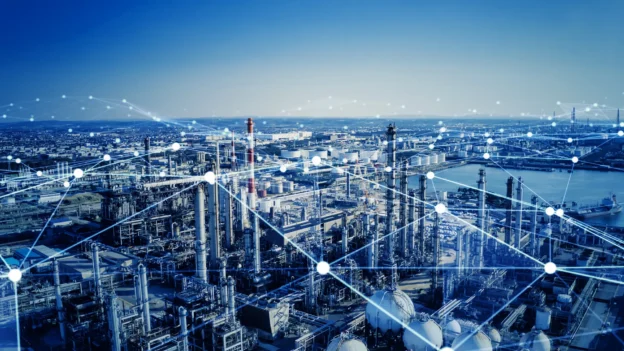The downstream sector (refining, distribution and marketing of petroleum products) is facing unprecedented challenges: tight margins, stricter environmental regulations and increasing pressure for decarbonization. In this context, digital transformation represents a strategic necessity to ensure operational efficiency, asset safety and business sustainability.
Downstream digitization: Beyond automation
Currently a large number of refineries and petrochemical plants have been incorporating automation technologies for decades, true digital transformation involves integrating advanced data platforms, artificial intelligence (AI), machine learning, advanced SCADA systems, digital twins, and IoT (Internet of Things) technologies to achieve a holistic, real-time view of the value chain, which, moves from a reactive to a predictive and, moreover, prescriptive strategy, with capabilities to simulate scenarios, anticipate critical failures and optimize resources on a plant or corporate scale.
Strategic applications of digital transformation
The following are some of the applications that are redefining downstream management:
1. Data-driven predictive maintenance
The integration of IoT sensors in rotating equipment, distillation towers, heat exchangers and pumping systems allows obtaining real-time operating parameters. By combining this data with machine learning algorithms, it is possible to anticipate failures more accurately, significantly reduce unscheduled shutdowns and optimize spare parts inventory management. As a result, it is possible to achieve a 30-50% reduction in unplanned maintenance events and increase operational availability to 98%.
2. Optimization of process units through digital twins
Using digital twin technology, it is possible to simulate the behavior of critical units (catalytic cracking, reforming, hydrotreating, etc.) under variable operating conditions, enabling real-time adjustments to maximize yields, minimize energy losses and reduce the carbon footprint per unit produced.
3. Intelligent management of terminals and logistics
In the distribution phase, the use of integrated management platforms with AI and geolocation makes it possible to plan optimal routes, reduce loading and unloading times, and ensure full traceability of the product from the terminal to the end customer; this has a direct impact on the efficiency of the supply chain and on improving indicators such as OTIF (On Time In Full).
4. Industrial cybersecurity
Digitalization increases exposure to cyber threats. Hence the need to integrate OT (Operational Technology) environments with industrial-grade security architectures, network segmentation, early anomaly detection and incident response protocols to ensure operational continuity.
Considerations for successful adoption
Implementing an effective downstream digital strategy requires a clear vision from top management and a roadmap aligned with business objectives. Here are some of the elements to consider:
- Digital maturity assessment: establish the starting point and prioritize high-impact areas.
- Data governance: ensure the quality, accessibility and security of operational information.
- Technical training: the development of digital competencies in plant personnel is as important as the technological infrastructure.
- Strategic alliances: collaboration with technology integrators, universities and industrial startups to accelerate innovation.
- Barriers to digital transformation in the Downstream
- Despite the potential of digital transformation in refineries and petrochemical plants, there are barriers that slow down its adoption.
- Legacy infrastructure: Most systems operate with obsolete technologies that make it difficult to integrate modern solutions such as IoT, AI or digital twins.
- Digital talent shortage: Shortage of professionals with expertise in advanced analytics, industrial cybersecurity and intelligent automation.
- Cybersecurity: The growing exposure of critical assets to digital networks increases the risk of attacks, generating reluctance to digitize.
- Implementation costs: Initial investment in hardware, software, integration and training tends to be high, especially for large-scale projects, generating caution in decision making.
- Organizational culture resistant to change: Digitization requires collaboration between operations, maintenance, information technology (IT) and management. However, this collaboration does not always come naturally.
- Difficulty in demonstrating an immediate return on investment (ROI): The tangible benefits of digitization are usually evident in the medium or long term, which complicates its approval by senior management in context of financial pressure.
Conclusion
Downstream is entering a new era where the ability to transform data into real-time operational decisions will be the differentiating factor. Digitization represents a tool to improve efficiency or reduce costs; it is the path to redefine resilience and competitiveness in an industry under unprecedented economic, environmental and social pressures. Making decisions today that enable the digital infrastructure of tomorrow is not a gamble, it is a strategic necessity.
This article was developed by specialist Euclides Quiñonez and published as part of the fifth edition of Inspenet Brief magazine August 2025, dedicated to technical content in the energy and industrial sector.

